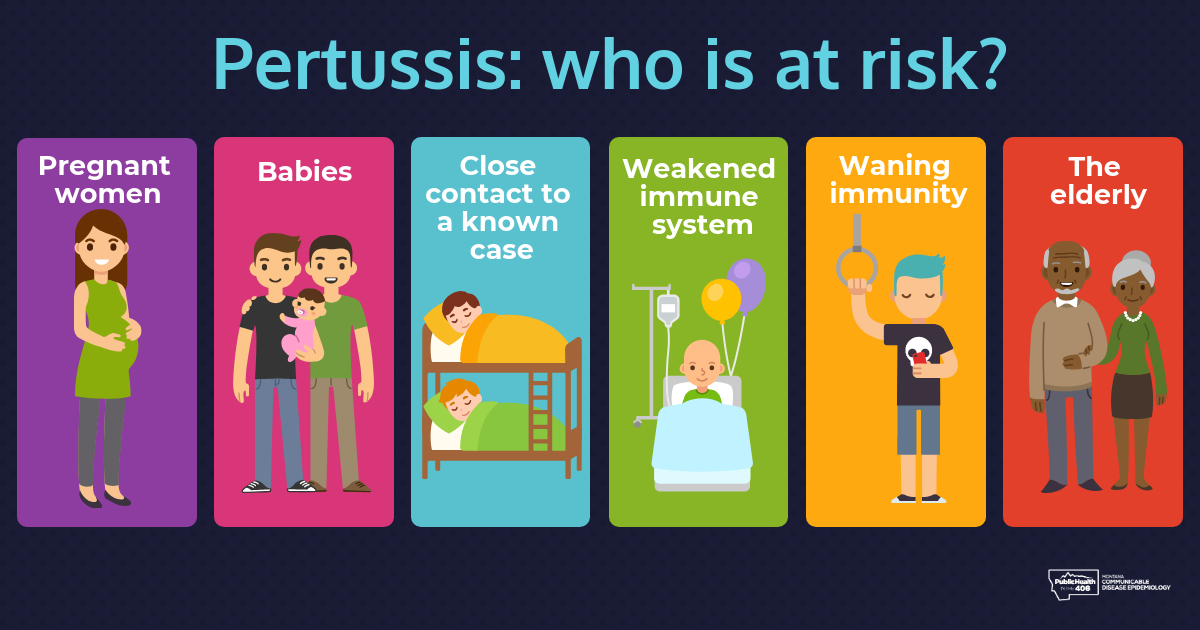Pertussis

What You Need to Know
Pertussis, also known as whooping cough, is a highly contagious respiratory disease. It is caused by the bacterium Bordetella Pertussis. Pertussis most commonly affects infants and young children and can be fatal, especially in babies less than 1 year of age. The best way to protect against Pertussis is by getting vaccinated.
The disease is known for uncontrollable, violent coughing which often makes it hard to breathe. After fits of many coughs, someone with Pertussis often needs to take deep breathes which result in a "whooping" sound.
Symptoms of whooping cough usually develop within 5 to 10 days after you come into contact with the bacteria that cause it. Sometimes symptoms do not develop for as long as 3 weeks.
Early symptoms: Stage 1
Early symptoms can last for 1 to 2 weeks and usually include:
- Runny or stuffed-up nose
- Low-grade fever (less than 100.4°F)
- Mild, occasional cough (babies do not do this)
- Apnea (life-threatening pauses in breathing) and cyanosis (turning blue or purple) in babies and young children
In its early stages, whooping cough appears to be nothing more than the common cold. Therefore, doctors often do not suspect or diagnose it until the more severe symptoms appear.
Later symptoms: Stage 2
One to 2 weeks after the first symptoms start, people with whooping cough may develop paroxysms—rapid, violent, and uncontrolled coughing fits. These coughing fits usually last 1 to 6 weeks but can last for up to 10 weeks. Coughing fits generally get worse and become more common as the illness continues.
Coughing fits can cause people to
- Make a high-pitched “whoop” sound when they are finally able to inhale at the end of a coughing fit
- Vomit during or after coughing fits
- Feel very tired after the fit, but usually seem well in-between fits
- Struggle to breathe
Recovery: Stage 3
Recovery from whooping cough can be slow. The cough becomes milder and less common as you get better. Coughing fits may stop for a while but can return if you get other respiratory infections. Coughing fits can return many months after the whooping cough illness started.
Causes
Whooping cough, also known as Pertussis, is a very contagious respiratory illness caused by a type of bacteria called Bordetella Pertussis. The disease is only found in humans.
Whooping cough bacteria attach to the cilia (tiny, hair-like extensions) that line part of the upper respiratory system. The bacteria release toxins (poisons), which damage the cilia and cause airways to swell.
How it spreads
The bacteria that cause whooping cough spread easily from person to person through the air. When a person who has whooping cough sneezes or coughs, they can release small particles with the bacteria in them. Other people then breathe in the bacteria. It also spreads when people spend a lot of time together or share breathing space, like when you hold a newborn on your chest.
People can be contagious for weeks
People can spread the bacteria from the start of the very first symptoms and for at least 2 weeks after coughing begins.
Taking antibiotics early in the illness may shorten the amount of time someone is contagious. Learn more about treatment.
People can spread the disease even if they don’t know they have it
Some people have mild symptoms and don’t know they have whooping cough, but they can still spread the bacteria to others.
Many babies who get whooping cough are infected by older siblings, parents, or caregivers who don’t know they have it. Learn what you can do to protect babies from whooping cough.
Two vaccines in the United States help prevent whooping cough: DTaP and Tdap. These vaccines also provide protection against tetanus and diphtheria.
The vaccine recommended for someone depends on their age.
- Babies and young children should get five shots of DTaP between the ages of 2 months and 6 years.
- Older children and teens should get one shot of Tdap between the ages of 11 and 12 years.
- Women should get Tdap during the early part of the 3rd trimester of each pregnancy.
- All adults who have never received one should get a shot of Tdap.
Learn more about CDC’s whooping cough vaccine recommendations.
Most people who get a whooping cough vaccine do not have any serious problems with it. However, side effects can occur. Most side effects are mild, meaning they do not affect daily activities.
Learn about the most common side effects of whooping cough vaccines:
Page last reviewed: September 19, 2025

